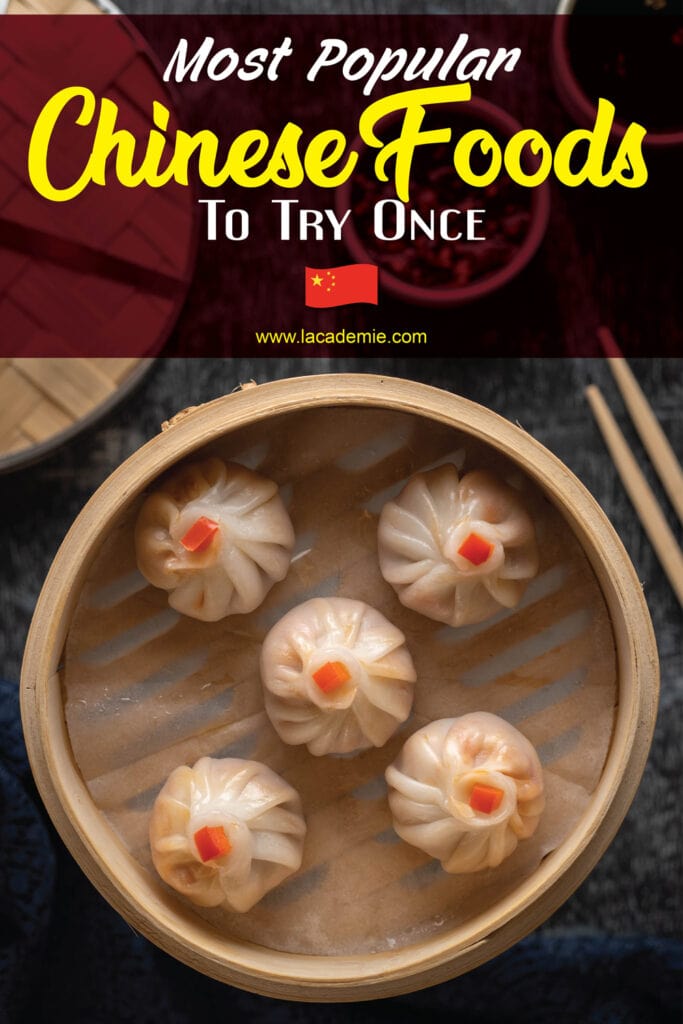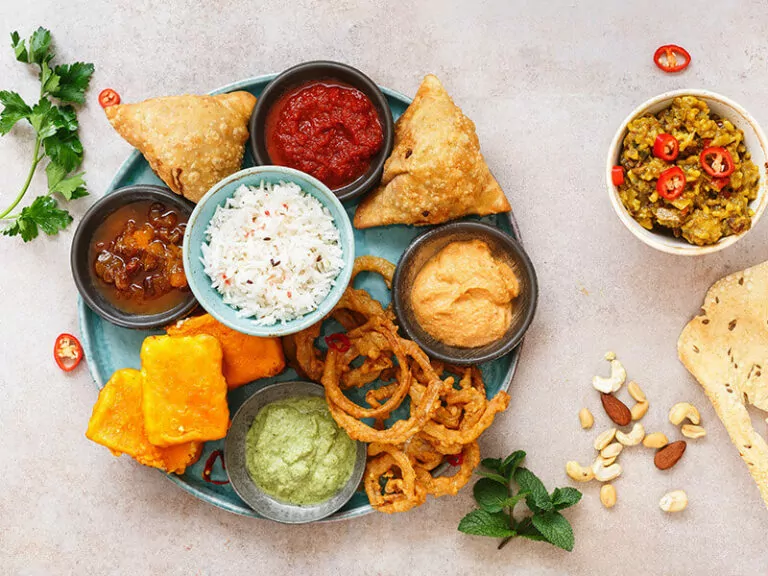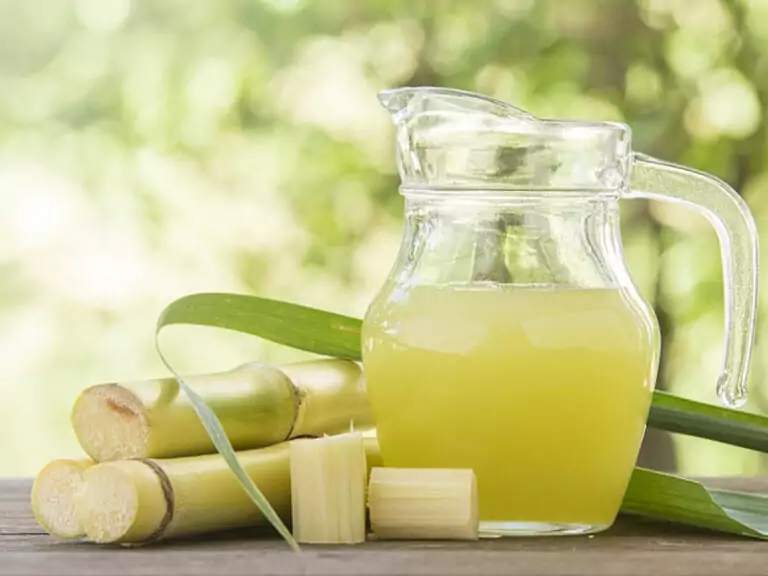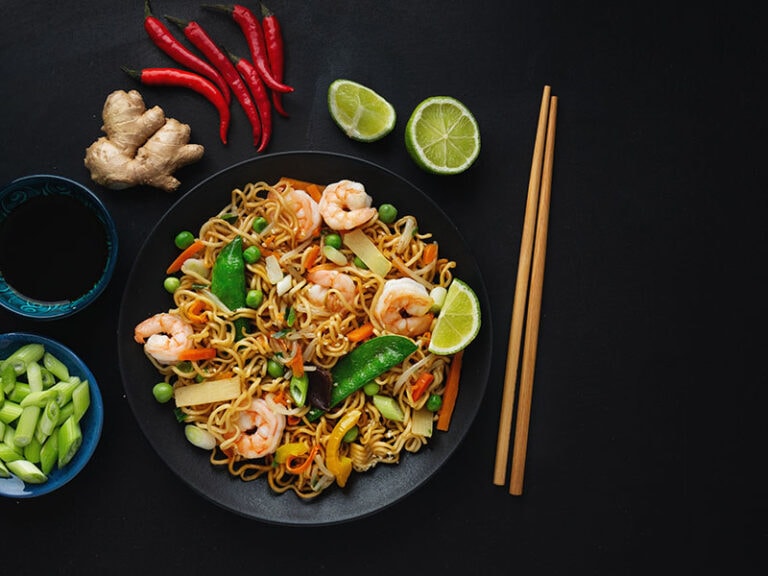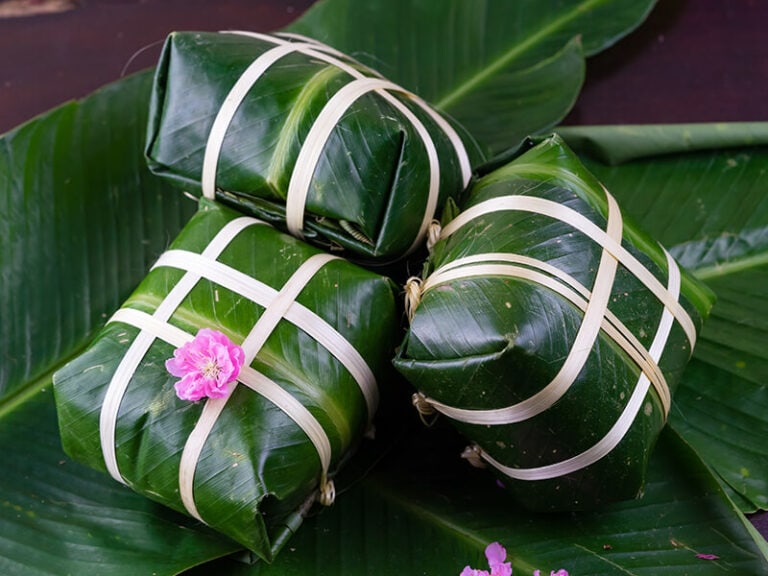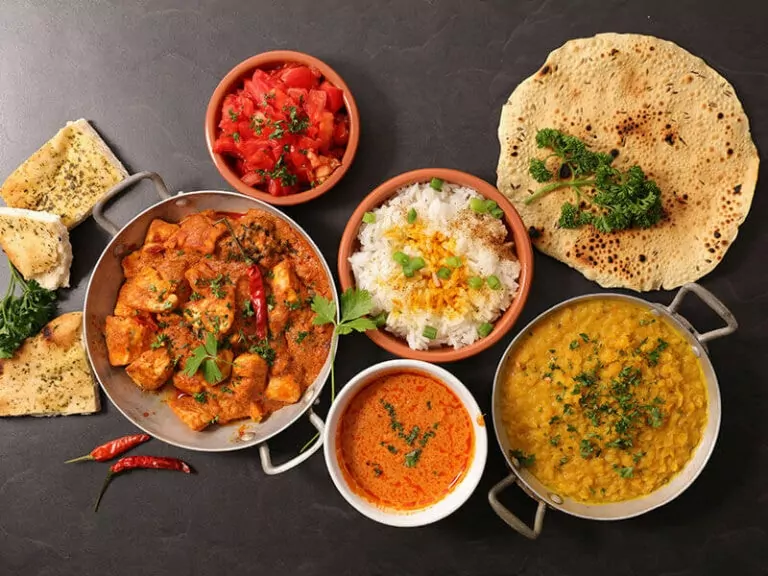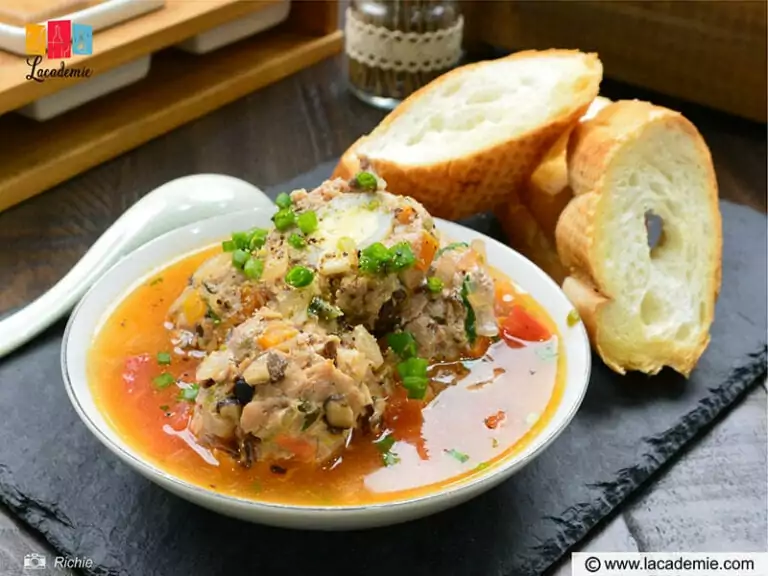Chinese foods or Chinese cuisine are prevalent worldwide thanks to their signature ways of using and combining ingredients, spices, and recipes. The dishes from this culinary culture all provide unforgettable taste experiences, and there is no reason to ignore them.
In the below section, I will introduce you to various famous dishes of Chinese cuisine that you should definitely not miss if you have the opportunity to visit this country. Let’s scroll down and learn more!
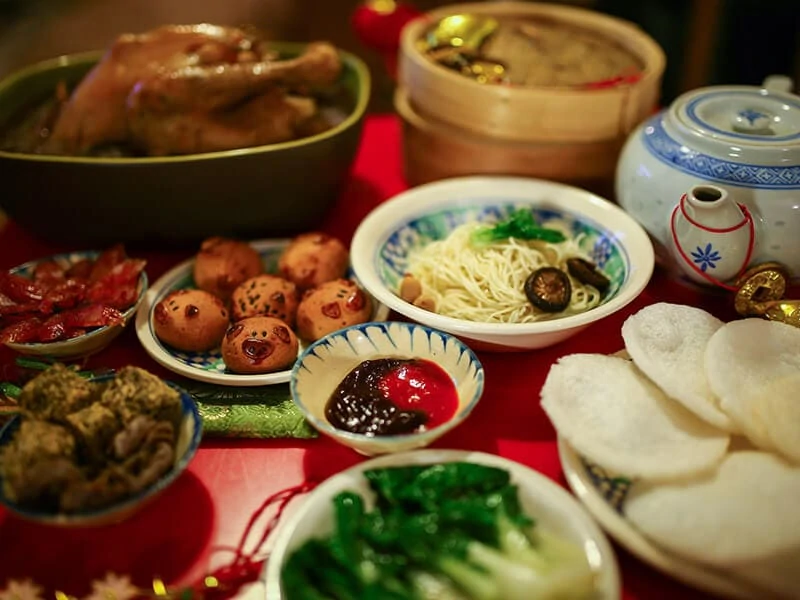
Overview Of Chinese Cuisine
Chinese cuisine is one of the world’s oldest and most diverse culinary traditions. It has a long and rich history that has evolved over 5000 years, with influences from different regions, ethnicities, and cultural practices.
The cuisine is broadly divided into eight regional styles, each with its unique flavors, ingredients, and techniques. These are Cantonese, Sichuan, Jiangsu, Zhejiang, Min (Fujian), Hunan, Anhui, and Lu (Shandong).
Chinese cuisine places a strong emphasis on the balance of flavors, with five main elements: salty, spicy, sour, sweet, and bitter.
It also incorporates a wide range of ingredients, including meats, seafood, vegetables, herbs, and spices. Chinese cooking techniques are also diverse, with methods such as stir-frying, deep-frying, shallow-frying, braising, steaming, boiling, roasting, and so on.
Famous Chinese Dishes
Prepare to delight in a feast fit for an emperor! These famous Chinese dishes will have you coming back for seconds and thirds.
1. Chinese BBQ Pork (Char Siu)
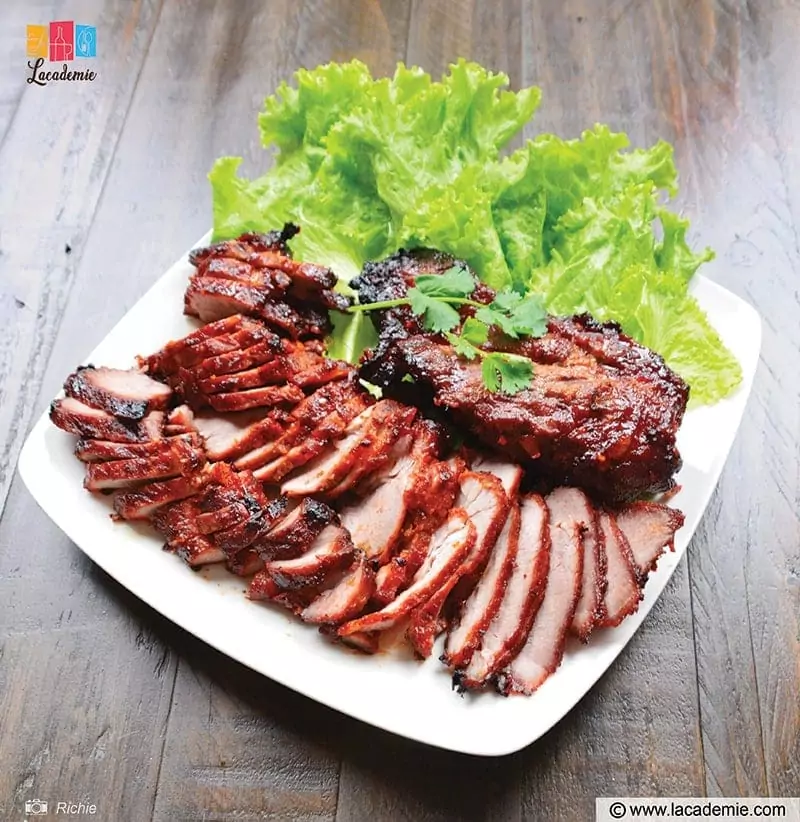
In Cantonese, ‘Fork Roasted’ is the direct translation of Char Siu, a method of cooking and flavoring meat for barbecuing.
Unlike some other Chinese pork-made dishes, the process of making Char Siu involves cooking the meat on skewers, either in an oven or over a fire. Traditionally, the Chinese use pork loin, butt, or belly for this dish, but you can use any type of meat you like when making it at home.
The magic of Char Siu lies in its marinade, which consists of a perfect blend of honey, hoisin sauce, red fermented bean curd, soy sauce, and five-spice powder. This combination creates a sweet and salty taste with a subtle hint of spices.
After cooking, the meat will be coated with an appealing dark amber exterior (thanks to the marination) while the interior will remain juicy and “glittering”.
You can serve Char Siu in various ways, from eating it with rice (and sauteed veggies), wrapping it in baozi or other dumplings, and serving it as a topping for soupy dishes. People also love to make dried char siu noodles from this delicacy.
All of them taste phenomenal, so you should give them all a go.
2. Tea Eggs (Chaye Dan)
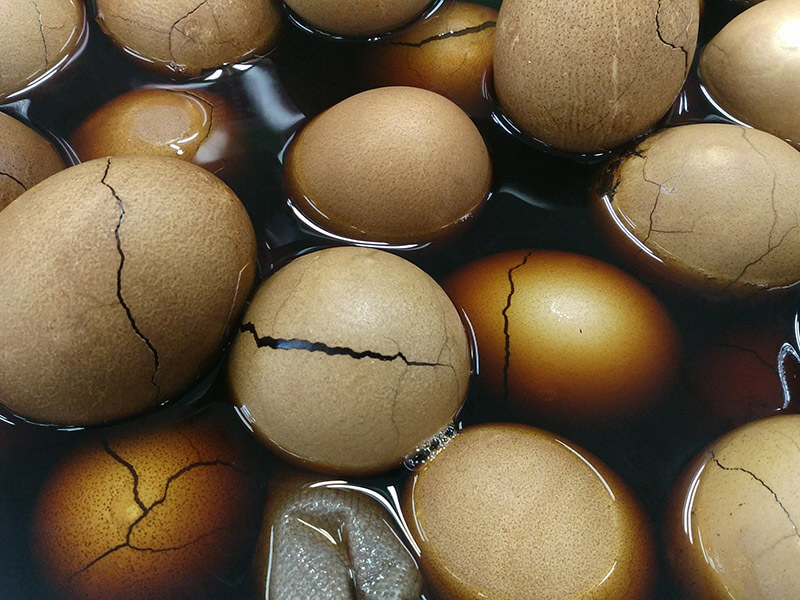
Tea egg is made by boiling an egg, slightly cracking its shell, and boiling it again in a mixture of tea, sauce, and spices. As a result of the cracks in the eggshell, the finished product has a distinctive marbled appearance, which has led to its nickname “the marble egg”.
Although it was originally created in Zhejiang province for food preservation purposes, it has since become a popular street food sold by vendors throughout Asia and beyond.
Tea eggs share the texture of hard-boiled eggs and are commonly served as a side dish or component, either hot or cold. Their unique flavor profile is a combination of black tea, cinnamon, soy sauce, bay leaves, and star anise, which also offer numerous health benefits.
To consume them, you will have many options. The first choice is to eat them as whole to fully taste the light, salty, and savory flavor; or serve these eggs with noodles, rice, veggies, or snack.
Tea eggs are also a traditional food eaten during the Dragon Boat Festival in Central China’s Nanchang region. After boiling, the eggshells are dyed red and placed in colorful net bags, which are then hung around children’s necks for good luck.
Some things you should know about these tea-flavored eggs.
3. Stir-Fried Tomato And Scrambled Eggs
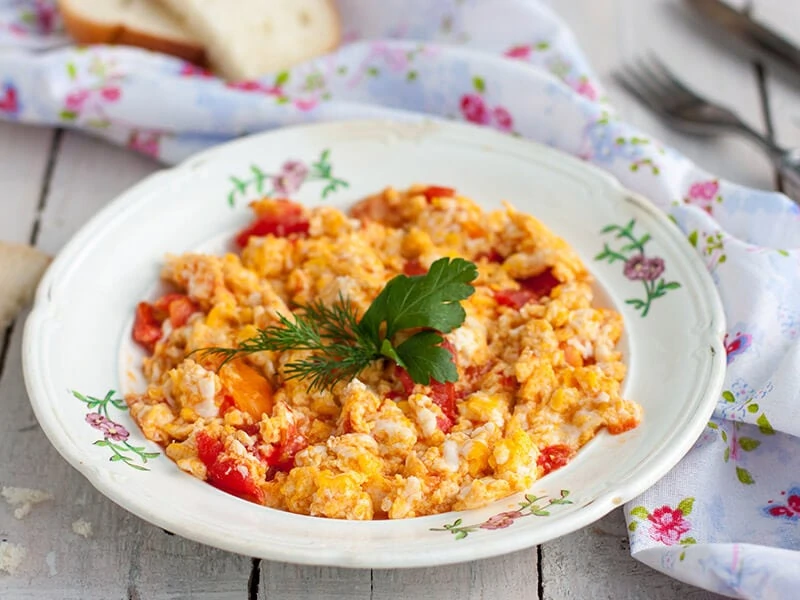
Stir-fried tomato and scrambled eggs is a well-known main course in China, prized for its simplicity and savory flavor. It is especially popular in student canteens, where it is an easy and satisfying option.
Interestingly, this dish has a unique story behind its creation. With the introduction of Western cuisine during the late Qing Dynasty and early Republican era, the Chinese started experimenting with new ingredients, leading to the fusion of tomatoes and eggs.
Contrary to the simplicity of ingredients, its taste is quite complex. The main components are fried eggs with richness and slightly sour tomatoes; a touch of spicy chili and pepper will make your dish bring out the perfect flavor.
I suggest you have this with rice for your Chinese mid-day meals because it is effortless to try at home and very cheap to buy at the store.
4. Egg Fried Rice (Dan Chaofan)
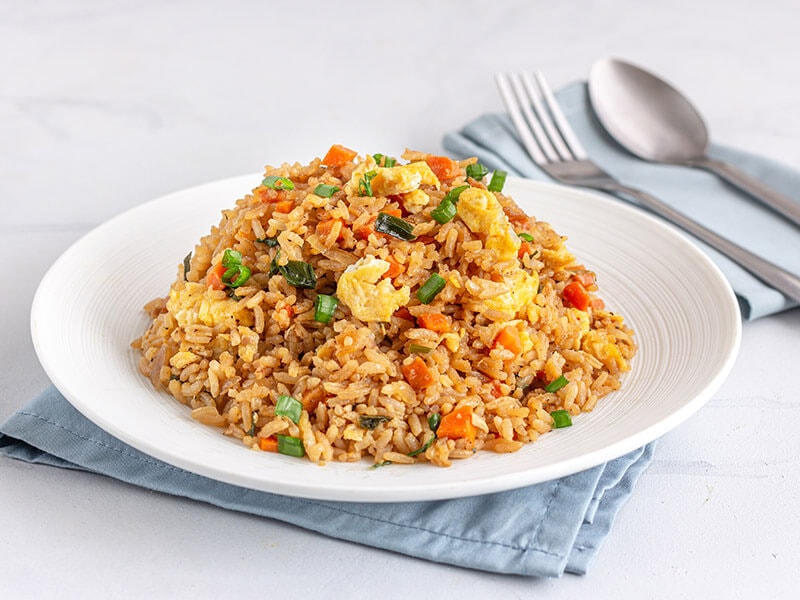
One of the most recommended Chinese dishes for breakfast that might be familiar to any Asian kid is this egg fried rice. If it is not the most delicious dish for you, it will still be easiest to find or prepare yourself.
The magic of Chinese fried rice begins with a sizzling blend of garlic, ginger, scallions, scrambled eggs, and minced meat in a hot wok. After everything is cooked to perfection, boiled rice is added to the mix to bring the dish together.
But wait, there’s more! Many chefs opt to enhance the flavor with soy sauce or oyster sauce for an extra umami boost. And for those seeking a luxurious touch, a dollop of butter can elevate the dish with its creamy richness.
There are no set guidelines for what ingredients you can or cannot include in your fried rice. Don’t be afraid to experiment – try adding shrimp, sausage, or fresh tomatoes to give it some extra flavor and color. And if you have any leftover veggies or rice, feel free to use those as well. The options are limitless.
It’s also a good idea to complete your authentic Chinese banquet experience with delicious fried rice. This timeless and beloved side dish is sure to impress your guests.
Egg fried rice and the secret behind its deliciousness will be shown here!
5. Chinese Steamed Baozi
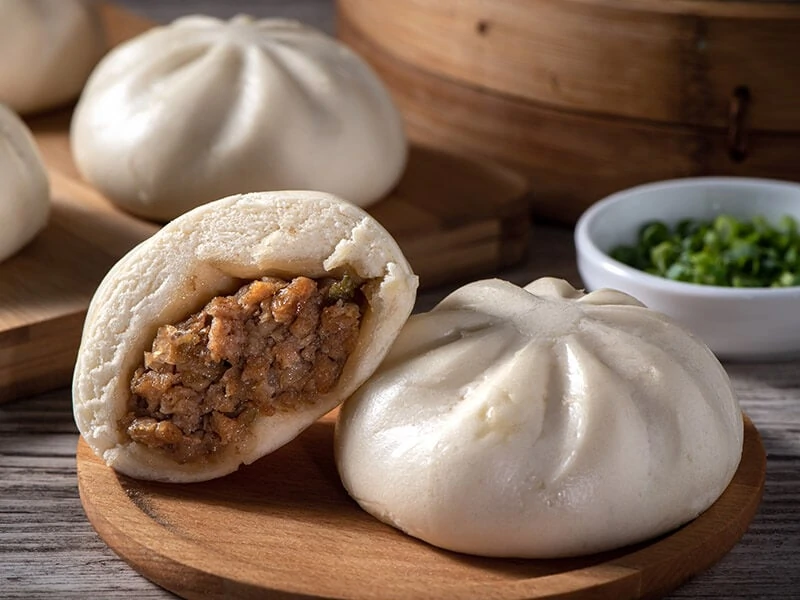
Baozi is a kind of Chinese bun made with yeast dough and filled with meat, or vegetarian fillings. These buns are popular in various Chinese cuisines and are usually steamed.
It is believed to have originated in Northern China as a variation of mantou. Sweets (sugar/ butter), meat (pork, chicken), seafood (shrimp/scallop), or mushrooms can all be used as fillings. Because of that, you will have many options to choose from.
With a big mouthful, all the tastes will blast in your tongue. It is only to be calmed by the gently sweet bread-like bun with just-enough-soft texture. Nothing’s better than curling up with a warm steamed bun and a cup of tea on a rainy day.
6. Dim Sum (Dianxin)
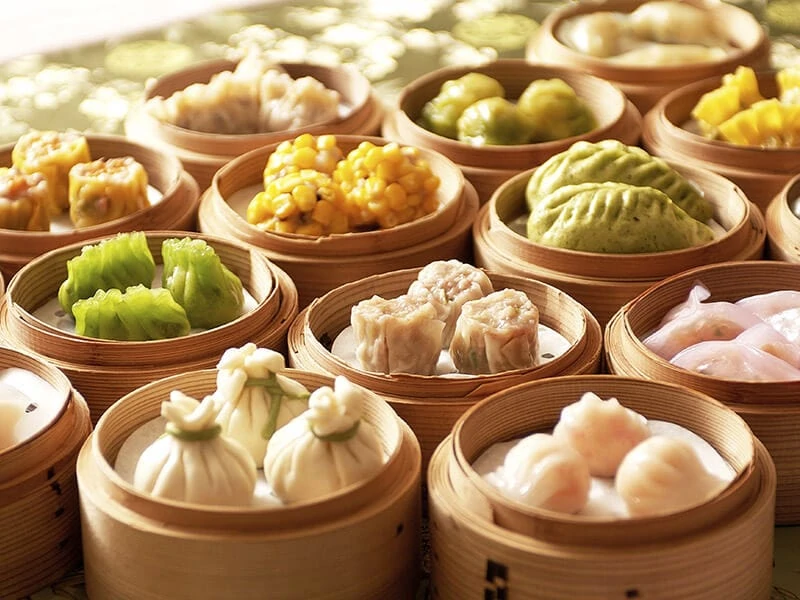
Dim sum is a customary Chinese dining experience consisting of small plates of dumplings and other snack dishes. Typically, dim sum is enjoyed during the late morning to lunchtime period, which is known as brunch time.
Like the Spanish custom of tapas, dim sum is typically served with tea and intended for sharing among loved ones.
There are various instructions for making these authentic Chinese dishes, and each recipe will create a different variant of dim sums. They can be a meaty Siew Mai, sweet, corn-coated Siomai, or chewy, enticing Har Gow.
These variants might be different in shapes and fillings, yet the idea of creating them is somehow the same. Their fillings are all covered with extra-thin, chewy wrappers that will turn more transparent when cooked.
You can easily find these delectable treats in many Hong Kong street vendors, Chinese restaurants, or delivery services.
Let’s see how varied these Chinese specialties (dim sums) are!
7. Wonton Soup (Yun Tun Tang)
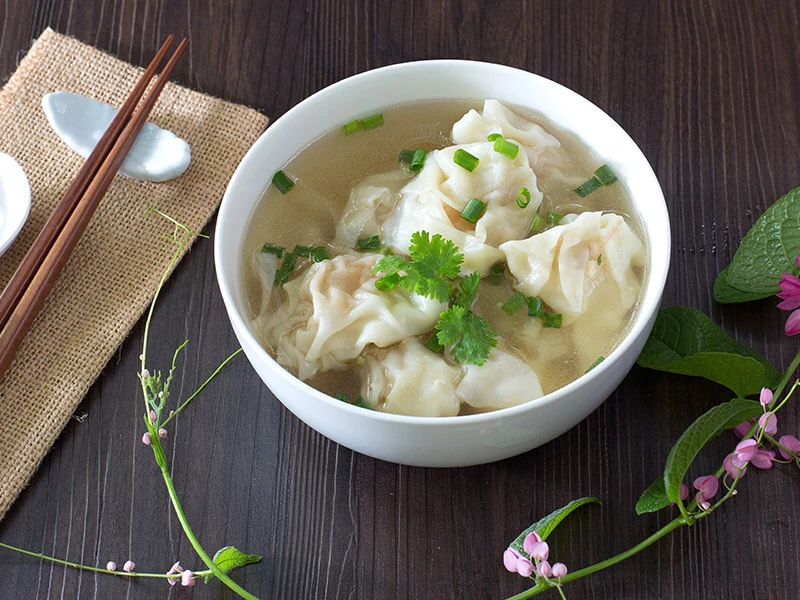
Like other typical Asian cuisines, Chinese cuisine also has famous soupy dishes. The first dish I would like to introduce is this wonton soup. The main component of this food with “W” as the first letter is small wontons made of minced meat (pork), poultry (chicken), and veggies.
Although the appearance and fillings of wontons might resemble dumplings, their skins/doughs are much thinner and have small sizes that you can eat a whole one in one bite.
Another notable feature that sets them apart from traditional dumplings is their shape, which often resembles silver ingots.
The allurement of this dish is its slow-cooking bond soup; it will deliver the slight sweetness and richness that can refresh your taste buds.
At some restaurants, there are also deep-fried versions of wontons, so it’s wise to double-check before ordering to prevent any unforeseen surprises. Nevertheless, whether you prefer them boiled or fried, wontons are a must-try for any dumpling lover.
8. Soup Dumplings (Xiao Long Bao)
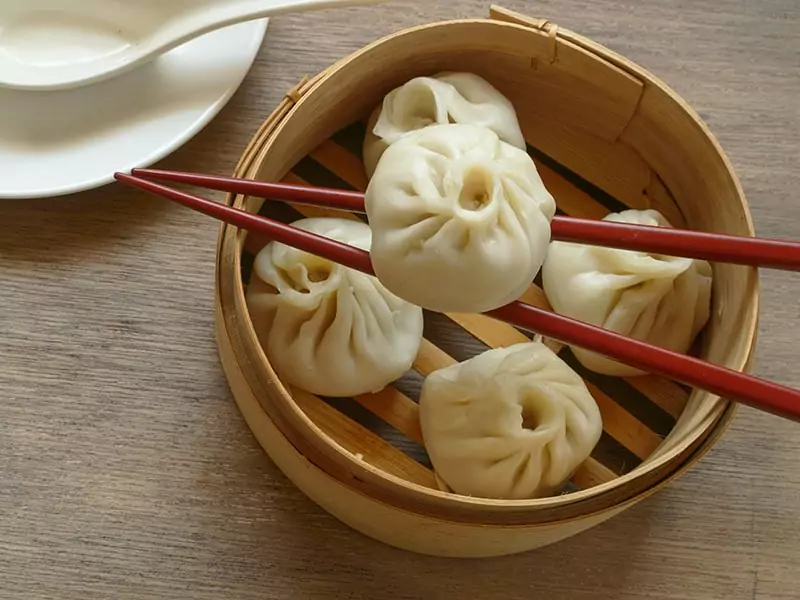
Hailing from China, xiaolongbao is a type of steamed bun that is small in size. These savory dumplings are typically served in bamboo baskets (known as xiaolong), nestled on a bed of dried leaves or paper mats, and are commonly enjoyed with a side of Zhenjiang vinegar and chili crisp for dipping.
Although often labeled as a dumpling, it is actually quite distinct from Chinese jiaozi or wonton.
The unmistakable feature of this delicacy is the sweet broth encased in the thin, chewy exterior. Other dumplings with juicy fillings may exist, but nothing compares to the soup’s sweetness inside this delicious food that begins with “X”.
While xiaolongbao typically refers to a type of dumpling in China, it can have a more specific meaning in certain areas both in China and overseas.
For example, in Jiangnan cuisine, xiaolongbao is synonymous with tangbao – a soup dumpling that is popular in Shanghai and Wuxi. Similarly, shengjianbao, which are similar to tangbao, are fried instead of being steamed.
From a dish from a little hamlet in Shanghai called Nanxiang, it’s grown famous worldwide for its distinctiveness and deliciousness. If you’re a gourmet, you won’t want to miss these delights.
The best introduction to know more about these special soup dumplings (xiao long bao)!
9. Beijing Peking Duck (Beijing Kaoya)
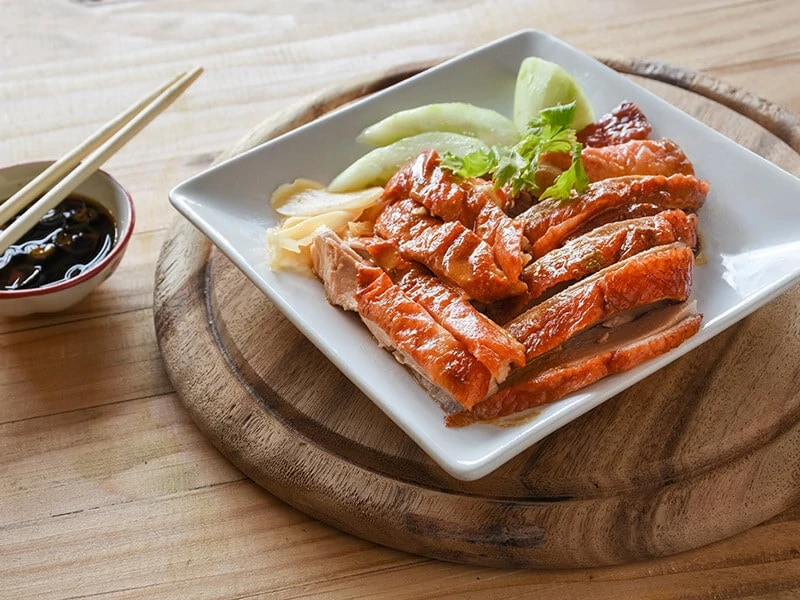
Peking duck is a traditional Chinese dish that has its roots in the Imperial era and is renowned for its thin, crispy skin. Typically, chefs serve the skin in thin slices to diners, while the meat is served in smaller portions.
If you have tried it once, you will definitely not forget the crispy skin that is perfectly seasoned with sweet, salty, and spicy flavors. Duck meat is also a money-making part of this dish. It’s delicately tender thanks to the moderate amount of fat, which melts in your mouth in just a few minutes.
When eating Peking duck, it is customary to enjoy the meat alongside spring onion, cucumber, and sweet bean sauce, all wrapped in a pancake roll. Occasionally, pickled radish is also included as an additional element.
10. Kung Pao Chicken (Gong Bao Ji Ding)
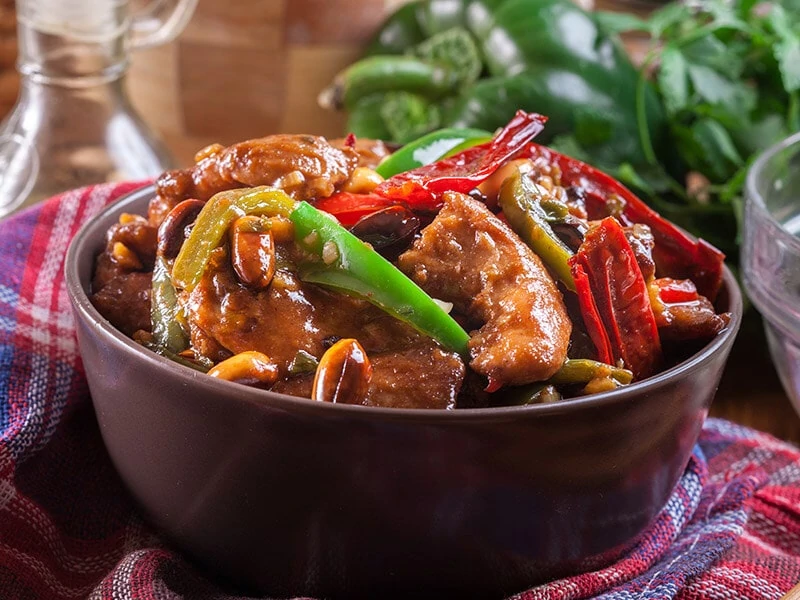
Kung pao chicken is a delicious Chinese dish with various ingredients besides the main protein, which is chicken (bell pepper, chili, vegetables), and is straightforward to prepare or order.
Based on that, you can have an ideal Chinese dinner anytime. On the other hand, this dish is completed with many strong spices, and in my opinion, it is pretty spicy and robust, which is a bit too much if you eat it alone.
The secret to Kung Pao Chicken’s appeal lies in its scrumptious sauce, which boasts a dual-layered flavor profile.
The first layer is contributed by the dried red peppers and scallions, delivering a satisfyingly spicy zing. The second layer, consisting of vinegar, soy sauce, and sugar, creates a mouthwatering blend of sweet and savory notes that’s hard to resist.
Therefore, to enjoy this dish to the fullest, I recommend eating this chicken dish with Asian-inspired accompanying food – white rice. With any savory dish that is too much for your palate, steamed rice will help you balance it out effectively. An iconic Chinese beverage can also help reduce the spiciness of this dish also.
Don’t worry if chicken isn’t your preferred meat! Simply replace it with beef or pork and bask in the same heavenly flavors. To complete your Chinese takeout spread, serve up some Chow Mein or egg fried rice alongside your Kung Pao dish.
11. Mapo Tofu
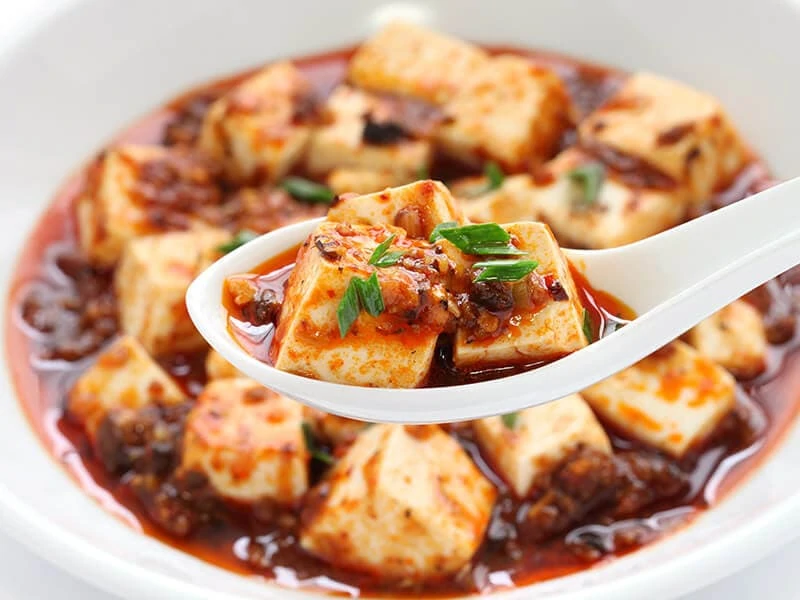
Applying the unique Sichuan spice, Sichuan peppercorns, this Mapo tofu delivers aromatic layers with spicy, booming, and addictive tingling in your tongue. The fresh, soft, and a bit rich tofu excellently mildens the hot and robust spice.
The story behind this traditional food is incredibly humble. This Chinese tofu-based delicacy initially came from a food stall of an old lady from years ago in Sichuan. The rustic tofu dish, at that time, was loved by many diners and the rumors spread quickly.
After a time, the scale of this food is not packed in its hometown. It is now known worldwide, and many variants have been created. The genuine love for this humble dish says it all. Don’t hesitate, give yourself the chance to enjoy it as soon as possible.
Whenever you feel like spicing up the flavors of your tofu, Chinese Mapo tofu should be your go-to choice. It’s not an exaggeration to say that this dish has an alluring flavor complexity despite featuring only a few simple ingredients.
12. Stir-Fried Noodles (Chow Mein)
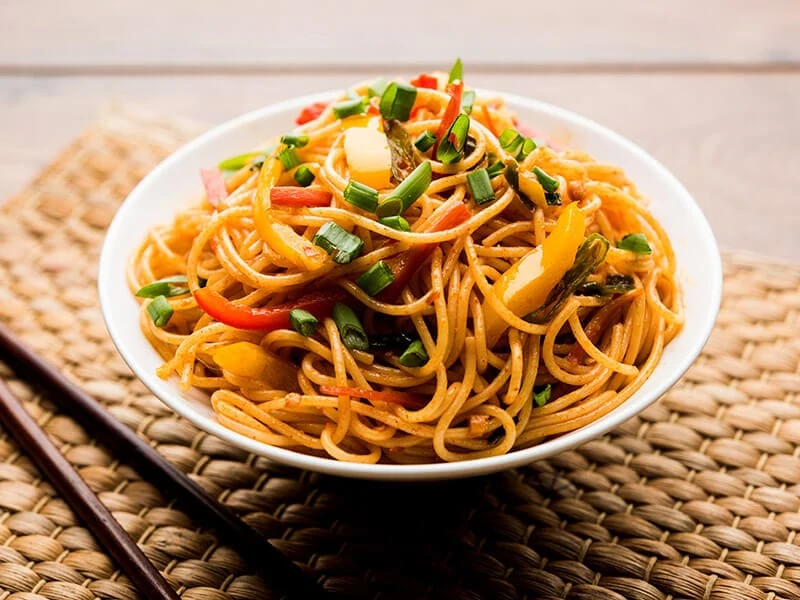
Chow Mein is a true classic dish that comprises tender noodles, paired with succulent diced meat, and a mix of fresh vegetables. All of these ingredients are cooked to perfection in a wok.
There is a small secret in the name of chow mein. “Chow” means “fried,” and “mein” means noodles. Therefore, you can basically understand it as fried noodles. There are distinctions that set chow mein and chop suey apart, so don’t mistake these two dishes despite their apparent similarities.
These Chinese fried noodles recipes are versatile since you can modify the ingredients, which will still turn out delicious. However, in this list, I’d like to suggest this healthy version of vegetables-paired chow mein.
Chow Mein’s enchantment stems from the skillful stir-frying method, which guarantees that each component is imbued with the ideal mixture of seasonings and sauces. The outcome is a harmonious blend of flavors.
Whether you choose to savor Chow Mein on its own or complement it with a delectable Chinese curry, it’s sure to delight your taste buds. For a bit of spice, experiment with pairing it with Kung Pao Chicken.
13. Lo Mein
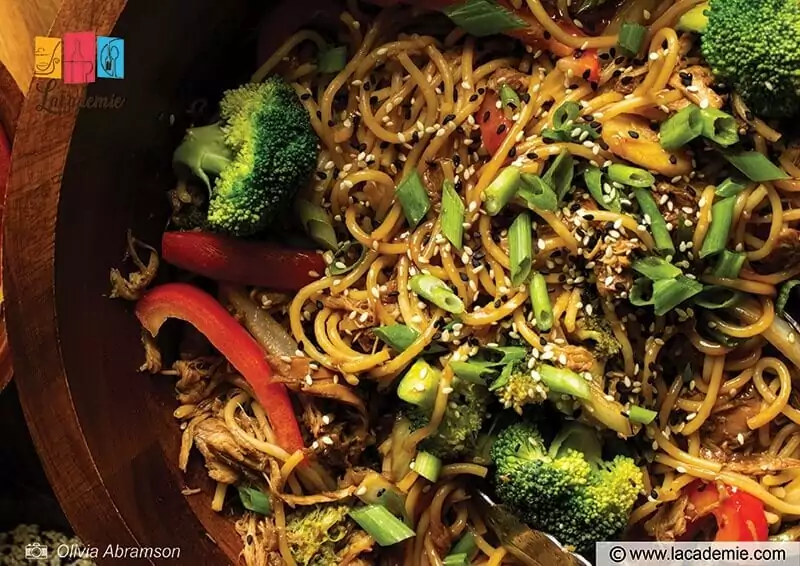
Lo Mein is a stir-fried noodle dish made with pre-boiled noodles, tossed together with a mixture of cooked veggies and protein in a wok, then coated in a flavorful sauce.
The main ingredients of Lo Mein can vary depending on the region, but typically include egg noodles, onions, bean sprouts, carrots, and some sort of protein like chicken, pork, beef, or shrimp. The sauce is usually a combination of soy sauce, oyster sauce, hoisin sauce and sesame oil.
Are you wondering about the main difference between Lo Mein and Chow Mein? Well, it all comes down to the noodles’ types and texture. Chow Mein has a crunchy texture, while Lo Mein is softer and more pliant.
As for the taste and texture of Lo Mein, it’s a bit of a mixed bag. The noodles are soft and chewy, with a slight sweetness to them. The sauce is savory and rich, with a hint of umami while the vegetables and protein add their own unique flavors and textures.
14. Snake Soup (Se Gang)
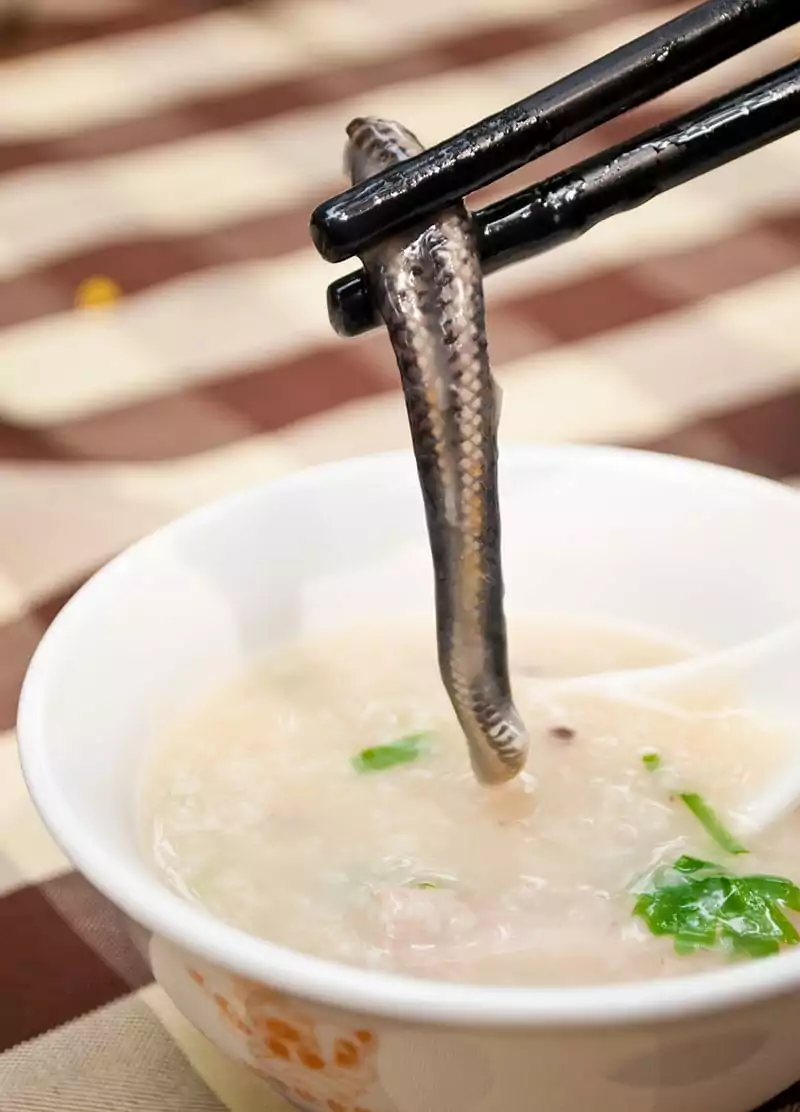
Snake soup is a Cantonese dish that is renowned for its flavor and potential health benefits. The soup is usually made with meat from a minimum of two distinct snake species and is commonly available in colder seasons at specialized establishments called “Snake King” or “Shea Wang” shops.
There is a myth that eating snakes can help to increase your longevity and incredibly boost your health status. Because of that, you can easily find this special soup in China.
If you are hesitant since you don’t know how the snake will taste, feel free to eat this soup once because it will taste exactly like chicken meat. The soup base will deliver a tasteful, warm, and mild sweetness that brings out a refreshing feel.
15. Moon Cake (Yue Bing)
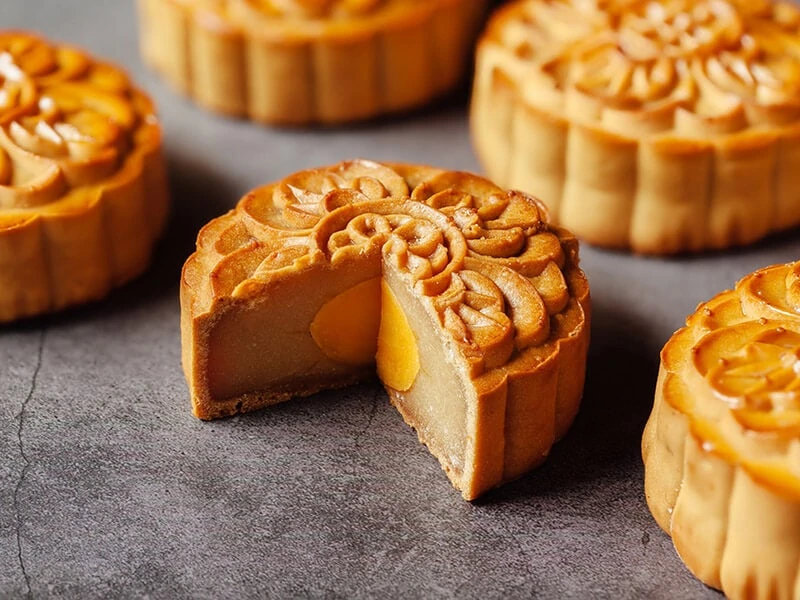
The next nominee on this list is a special Chinese sweet treat for the traditional mid-autumn party. These cakes are first to appear since the Shang Dynasty from a long time ago and gradually become a must-have treat for that feast.
There are many reasons why these iconic sweet treats in Asian cuisine are called “mooncakes”, one of them is the dessert’s shape and its salted egg yolk filling. Although the traditional fillings only include mung beans and salted egg yolk, nowadays, you can have much more options.
The modern mooncakes’ fillings vary from the sweet kinds like red bean paste, nuts, lotus seeds, dried fruits to the saltier, savory ones like ginkgo, pork floss, ham, and many more. No matter what type you prefer, you should prepare some good tea to serve with it.
Mooncakes hold great cultural significance for Chinese people and are more than just a food item. They are a symbol of spiritual connection and a tradition that is deeply ingrained in the hearts of the Chinese people.
During the Mid-Autumn Festival, families come together to enjoy mooncakes and share the joy of the occasion. People also use mooncakes as gifts to express love and best wishes to their loved ones and friends.
16. Pan-Fried Scallion Pancakes (Cong You Bing)
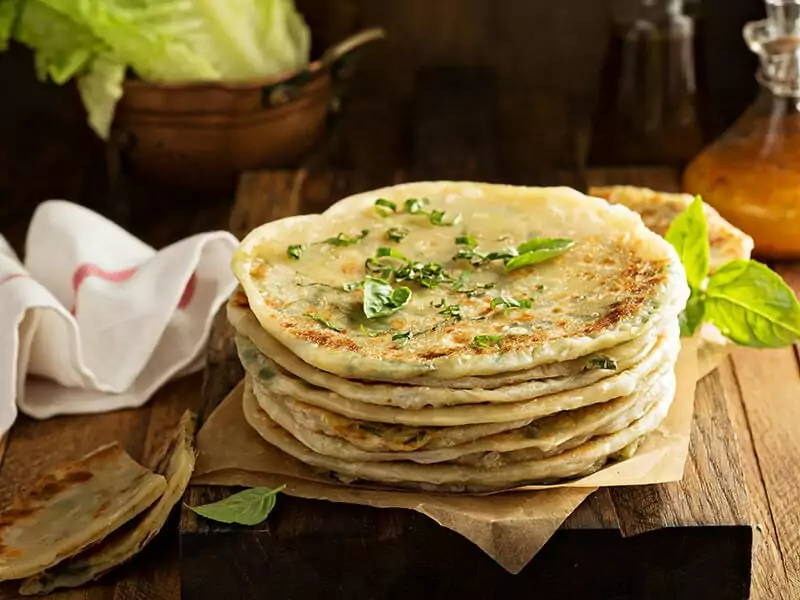
If you want a light and quick breakfast with a Chinese dish, you should opt for these Chinese-styled scallion pancakes. These scallion-filled flatbreads are normally sold on the Chinese streets, so you can easily grab one.
Unlike the traditional Western pancakes made from batter, Scallion Pancakes are made from dough. The dough is infused with spring onions and sesame oil, giving Cong You Bing a chewy texture on the inside and a satisfying crunch on the outside.
Pan-fried to perfection, these pancakes are crispy and fragrant, leaving your taste buds begging for more. Don’t dip your pancakes with syrup; they are savory food, so you should better eat them as is.
17. Spicy Crawfish (Mala Xiao Long Xia)
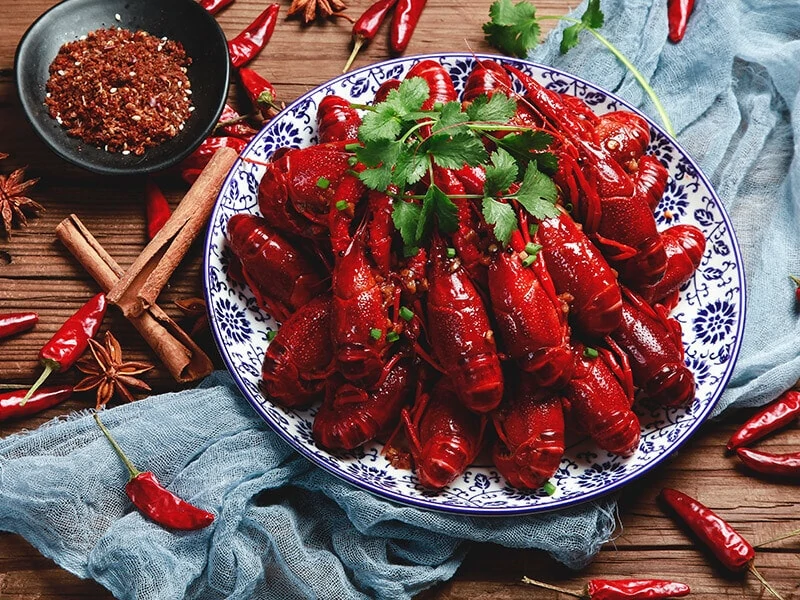
Xiao Long Xia, which translates to “little lobster” in Mandarin, is a delicious crawfish dish that is particularly flavorful when cooked with its head and shell intact.
Its succulent, sweet meat provides a pleasing contrast to robust flavors like garlic, spice blends, or beer.
You have probably seen this dish somewhere online or in well-known cookbooks of Chinese cuisine, and don’t hesitate to try it! To describe the flavor of crawfish, I would say it is chewy and tasty. The taste will remind you of shrimp and crab, but it will be sweeter and meatier.
Prepare this meal with a spicy sauce (heavy or light, depending on your preference) and sweet veggies like corn to balance the flavor. If the spiciness gets a bit too much, don’t forget that China offers a wide variety of delightful drinks that you can enjoy on the side!
When eating, detach the iridescent flesh from the crawfish body’s shell, dip it in the sauce once, and chew slowly to feel the spicy and sweet flavors spread throughout your tongue. Is this enough to persuade you to give this dish a try?
18. Chinese Prosperity Cake (Fa Gao)
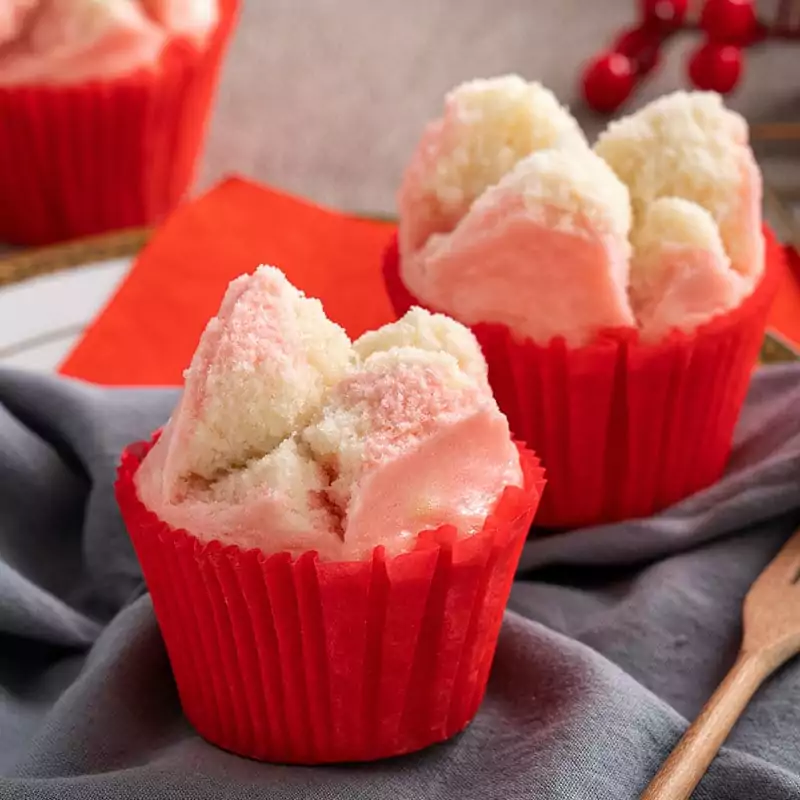
In Chinese, the word “Gao” translates to “cake”, while “Fa” refers to the leavening process used to create the cake’s fluffy texture.
But “Fa” also has another meaning – “prosperity” – which is why this cake is known as the Prosperity Cake and is traditionally consumed during Chinese New Year to bring good luck.
While it’s traditionally eaten during Chinese New Year, this cake is also enjoyed on other special occasions, such as weddings.
In fact, the Hakka call it “fat pan” and believe that the bigger the split on the top of the cake (known as the “xiao” or “smiling”), the greater the fortune it will bring.
With its fluffy texture and blooming flower-like appearance, this cake is also sometimes called Cantonese sponge cake or Chinese smiling steamed cake.
Regional Chinese Specialty
If you are familiar with the above dishes and need something more, move on to this section. In this part, I will introduce you to some outstanding local specialties of China that you may want to dig deeper into.
19. Shanghai Steamed Hairy Crab (Qingzheng Dazhaxie)
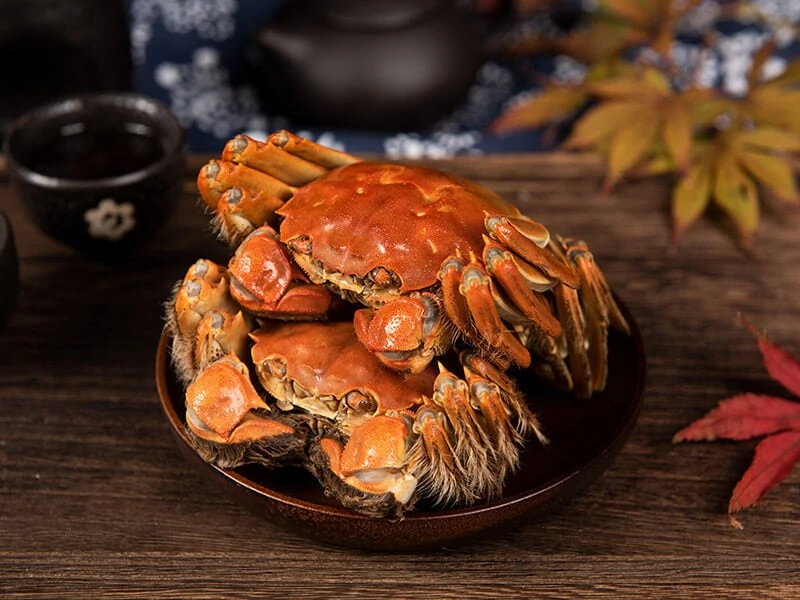
Steamed crab sounds ordinary with nothing special, so how do these Shanghai-style crabs stand out in the crowd? It is not a coincidence; the uniqueness lies in crabs that are hard to find elsewhere other than this province.
These freshwater crabs are in-season in September every year, and they are usually served in luxury restaurants, not street food stalls.
The Chinese seafood delicacy is traditionally served whole, tied with strings, and steamed in a bamboo basket. It is typically accompanied by a dipping sauce prepared with sugar, ginger and rice vinegar, which enhances its delicate and sweet flavor.
The golden roe of these hairy creatures lends incredibly creamy and buttery flavors with much sweeter flesh compared to the regular ones.
If you wonder how these hairy crabs are served, this introduction will help you out!
20. Guangzhou Scalded Shrimp/Prawns
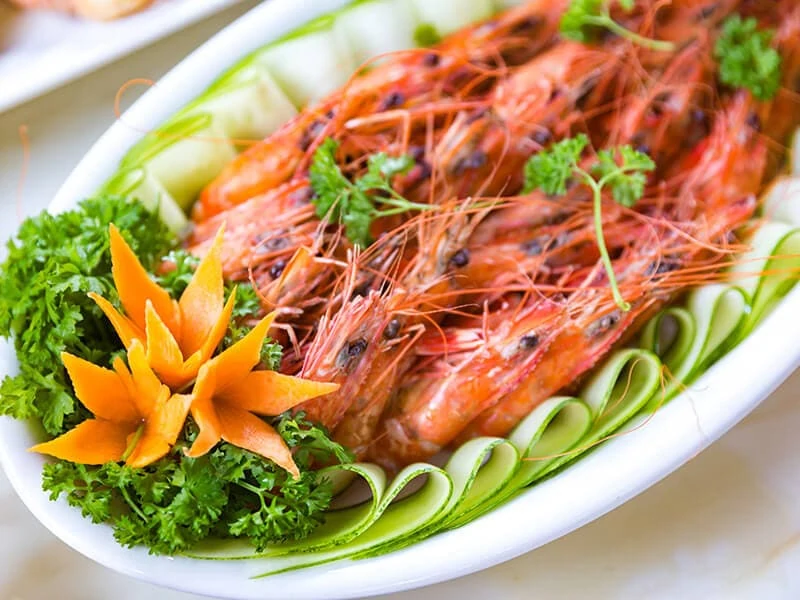
Scalded Prawns are a popular traditional dish in Guangzhou. The dish typically consists of shrimp as the main ingredient, with scalding being the only cooking method used.
The allurement of this shrimp delicacy from China lies in its simplicity. Sometimes you don’t need to over-complicate things to make them better, and this straightforward prawn dish will be solid proof.
All you can see will only be some blanched prawns with pinkish, transparent milky-like flesh. Guangzhou people purposely process these delicate ingredients to retain their exquisite natural tastes fully.
If you are still questioning, how about giving it a try and verifying it yourself.
21. Shandong Braised Sea Cucumber (Cong Shao Haishen)
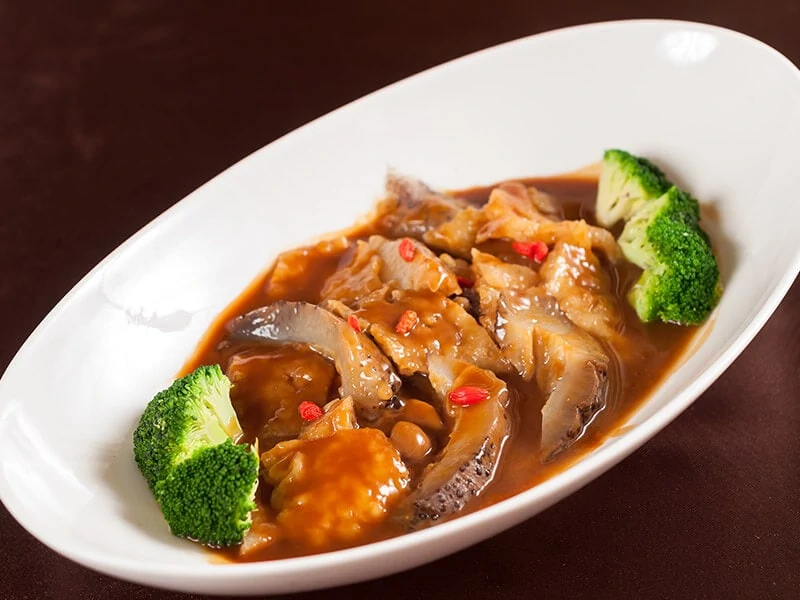
Usually cooked with oyster sauce and scallions, this braised sea cucumber offers you any tastes you can expect from the unique Shandong cuisine. From the rich combined with freshness and bright aroma to the main seafood ingredient, it will represent all of that.
You can also expect the signature mix of sweet, sour taste from this delicacy, and don’t forget white rice to pair with it. Just imagining drizzling a spoonful of its iridescent sauce over a bowl of steaming hot rice makes my mouth water already.
22. Anhui Fried Hairy Tofu (Mao Doufu)
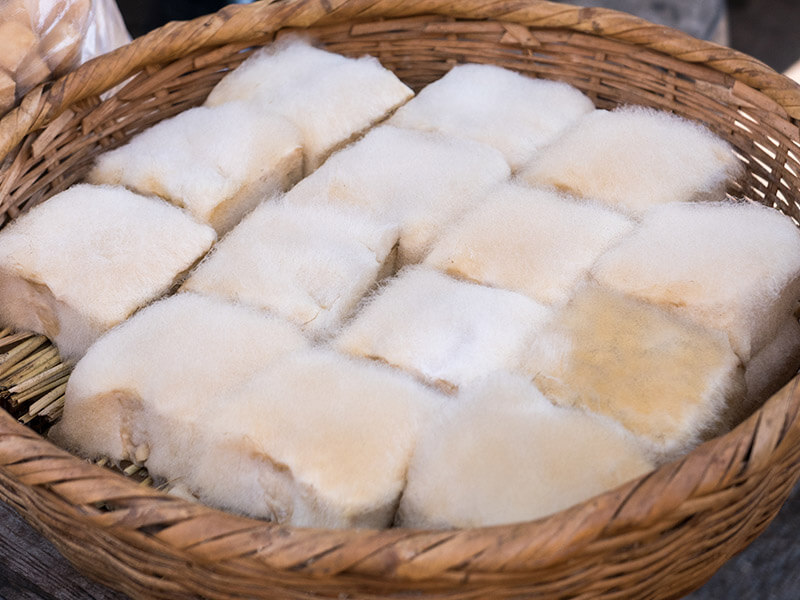
Fried Hairy Tofu is a renowned meatless delicacy in Huizhou, Huangshan, with a history of over 500 years. Because of the distinctive local environment, the fermented tofu is naturally covered with white mold.
The result is hair-like filaments on its surface, hence the name “hairy” tofu. Because of its peculiar scent, this Anhui specialty dish is considered one of the most difficult meals in Chinese cuisine, yet you would be remiss if you did not try it at least once.
To lessen the smell, the exterior and “hair” of fermented tofu are usually fried until crispy golden and sprinkled with a few spicy and salty seasonings.
When you bite into it, you will first notice the crunchiness of the skin, followed by a strong fragrance that rushes into your nostrils. Right after that, a greasy, smooth flavor from the interior will overflow on the tip of your tongue.
It will be one of the most pleasurable culinary experiences you have ever had.
Taste test on the authentic Anhui fried hairy tofu you should not miss.
23. Cantonese Sausage (Lap Cheong)
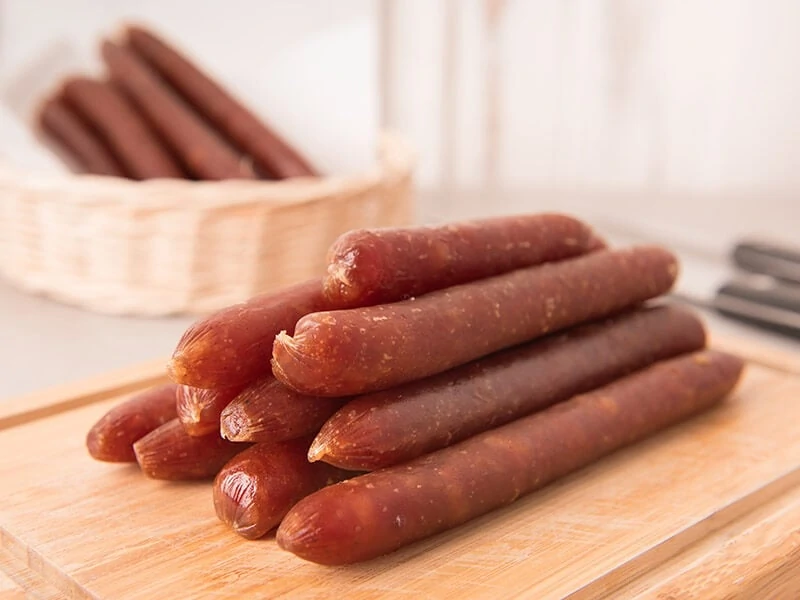
This Cantonese-style food – Cantonese sausages stand for Chinese cuisine and play a big role in their traditional culinary culture. It is because this type of specialty appears on many Chinese family’s new year meals or is simply served with white rice for dinners.
Those special Chinese sausages have non-complicated ingredients, including chopped/ground pork and several robust condiments/spices (soy sauce, wine, Szechuan peppercorn, and other basic seasonings).
Lap Cheong is unlike any sausage that you are accustomed to. It is dry-cured, hard to the touch, and has a distinct sweetness that comes from the sugar, rose water, salt, and rice wine used in its preparation.
Lap Cheong’s firm texture, comparable to that of salami, is the result of the air-curing process. However, once cooked, the sausages become softer and more pliable. That’s why it can be used in a variety of dishes, from stir-fries to steamed dishes.
These sausages are made in many regions of China, such as Hunan, Shanghai, or Szechuan/Sichuan, and each of those places has their own recipes to create regional uniqueness.
24. Spicy Hunan Red Braised Pork (Hong Shao Rou)
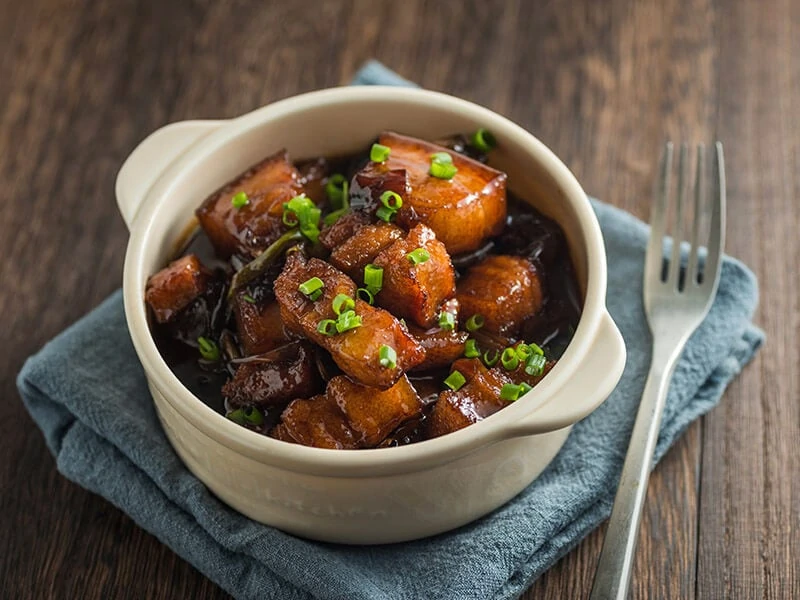
You can easily find this red braised pork anywhere in China, and each region will have their own version of this dish. In Hunan, an excellent cuisine renowned for the uses of spicy spices and sour food, their red braised pork dish will probably be hot and more intense.
The main ingredient for this dish is the streaky pork belly. The meat will be seared before braising, so the exterior will have a beautiful dark amber color when cooked. It will be chewy on the outside and tender on the inside, then melt in your tongue like jelly.
Enjoy hot rice because the rich, meaty, sweet, and spicy taste will be balanced and surely leave you satisfied.
The best red braised pork cooking instruction that will make you want to have a bite of it immediately.
25. Shanghai Sweet And Sour Pork Ribs (Tang Cu Paigu)
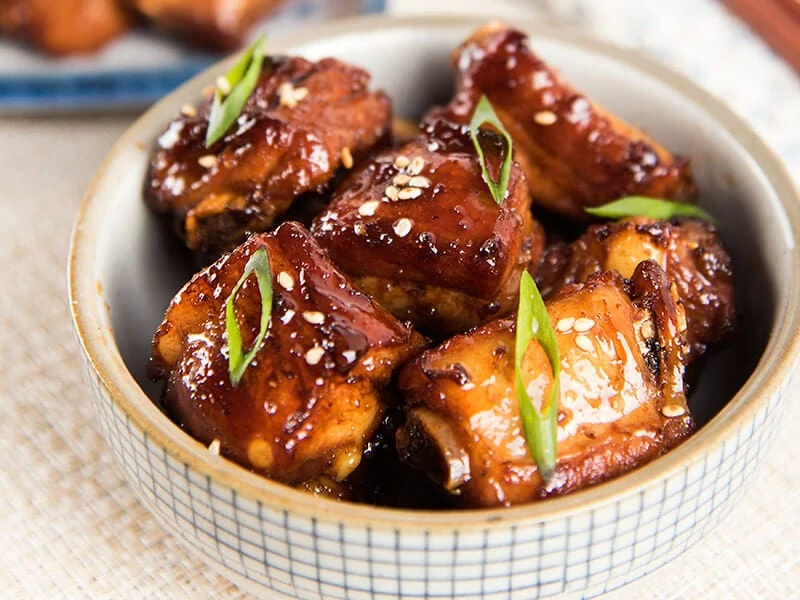
This will be one of the few non-spicy Chinese dishes you can give your little ones to try, and it will also be relatively easy to eat.
This rib dish will have relatively firm meat. It will be quickly deep-fried in oil before being cooked with aromatic spices and a layer of sticky sauce.
It features a distinctive chewy texture and a crispy, caramelized surface that is loaded with flavor. And, of course, it will be even more perfect if eaten with starch, like rice. Who doesn’t love the combination of sour and sweet-savory dishes with rice?
26. Hunan Steamed Fish Head With Diced Hot Red Peppers (Duo Jiao Yu Tou)
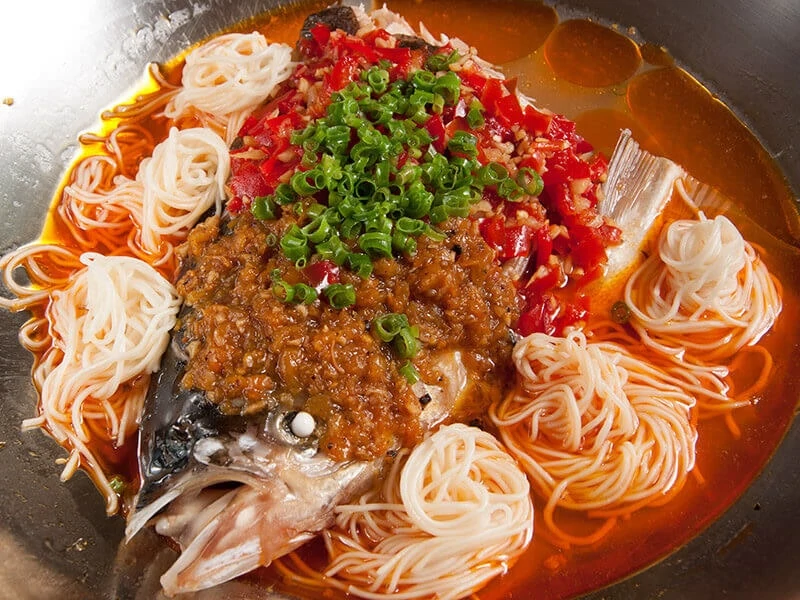
Huang Zongxian, a renowned mathematician of the Qing Dynasty (1644 – 1911), is credited with the origin of this dish. While traveling through Hunan Province, he stayed with a family who served him a dish of steamed fish cooked with chopped chili.
Impressed with the dish’s flavor, Huang obtained the recipe from the hostess and brought it back home. Later, the recipe was spread and favored by more and more people.
This classic dish is a crowd-pleaser because it does not only delight the taste buds but also provides health benefits such as lowering blood fat, enhancing brain function, and anti-aging effects.
You may think that the fish head is very fishy, but if you know how to cook a fish head like this, it will definitely not be fishy anymore. Rinse, halve, and stuff plenty of strong spices in it will help you mask the unpleasant smell of the fish.
The highlight of this dish is also the main ingredient to help you successfully cover the scent, chopped/diced chili. Moreover, steaming will infuse the fish head with the rich flavor of diced hot red peppers while maintaining its delicate texture. The beautiful red color will make you want to have a taste.
27. Sichuan Hot Pot (Huo Guo)
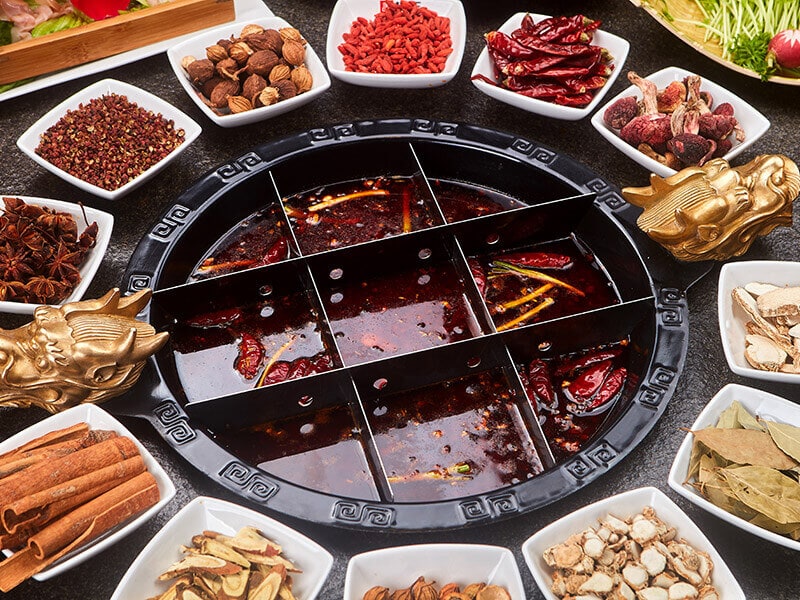
I’d be making a tremendous mistake if I didn’t include this delicacy on my list. The toppings for such dishes, like those for other types of hot pot, vary. Thus the broth is one feature that distinguishes them.
And the secret lies in the spice combinations of this food. Since Szechuan/Sichuan is famous for their hot spices, they also include many spicy spices. One of them is the one-and-only Sichuan peppercorn.
Once having the first sip of the hot pot’s broth, you can immediately feel the irresistible spiciness together with numbing and tingling effects on your tongue. Believe me; the effects will last until you finish the meal.
Do you want to have some more reviews? Here you are!
28. Sichuan Twice-cooked Fatty Pork Slices (Hui Guo Rou)
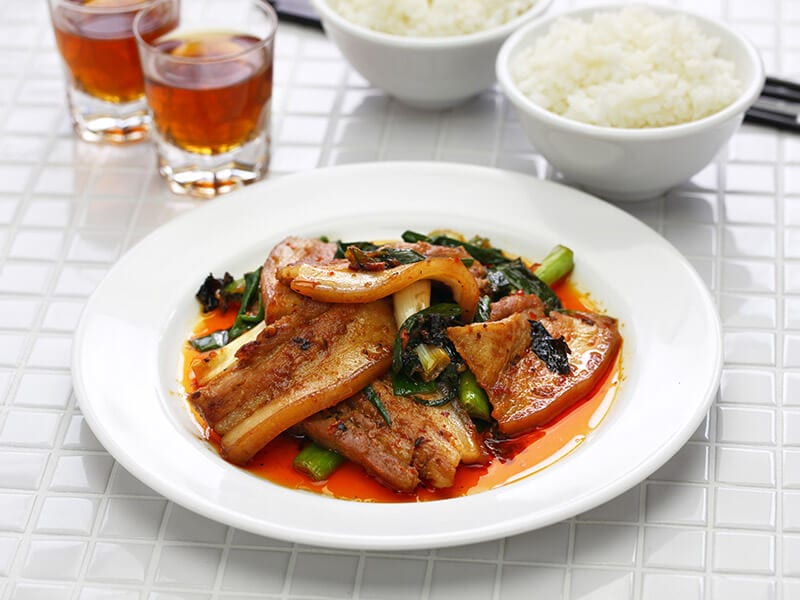
As a customary practice, the Sichuanese people observe a tradition of enjoying a grand feast every 1st and 15th of the lunar month, with the delicious and savory Twice Cooked Pork as the featured dish.
The term “twice-cooked” in the dish’s name refers to the process by which the pork belly is cooked twice – first by boiling, and then by stir-frying.
Originating from Sichuan, this dish varies slightly in preparation from one chef to another. And the final result largely depends on the chef’s skill.
Even though it resembles red braised pork, it is an entirely distinct meal. Pork buttock (which has more fat than pork belly) is utilized, and the processing method is different.
This food’s pork will be quickly boiled until half-cooked, then sautéed with veggies and spices in Sichuan style chili oil to make a gorgeous dish, as seen in the photo.
Allow me to give you a description of what it tastes like. It will be a wonderful mix of spicy, sweet, and fatty lard flavors. What a fantastic dish!
29. Zhejiang’s Beggar’s Chicken (Qi Er Ji)
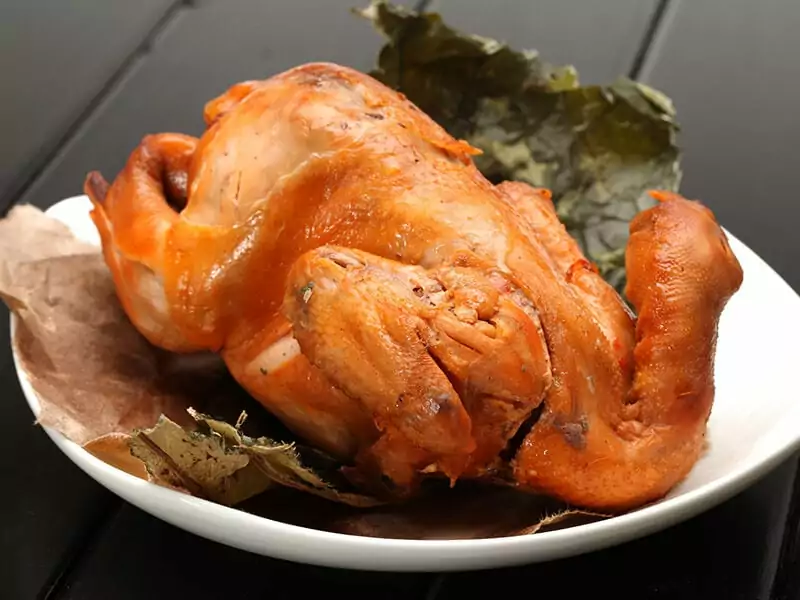
If you want to experience eating food with a hammer, you should try this beggar’s chicken. Because in this dish, a whole chicken will be tightly wrapped in lotus leaves to retain moisture and then covered with a layer of mud.
There was a legend behind the unique cooking method and name of this dish. The story was about a beggar, he had a chicken to eat that day but he didn’t have anything to cook it up. Then he came up with that genius cooking method, which has become ubiquitous until now.
Besides the tender chicken that melts due to being cooked for many hours, the juice from vegetables, chicken, and spices will be delightful sweet/mellow. Blended with the fragrant aroma of lotus leaves enhance the food’s exquisiteness.
Brief guidance on how this beggar’s chicken dish is made you will love!
Chinese Fusion Foods
What about those dishes that combine other cuisines and Chinese? They are, of course, also excellent, and here are a few of my recommendations for you.
28. Chinese-American Orange Chicken (Chen Pi Ji)
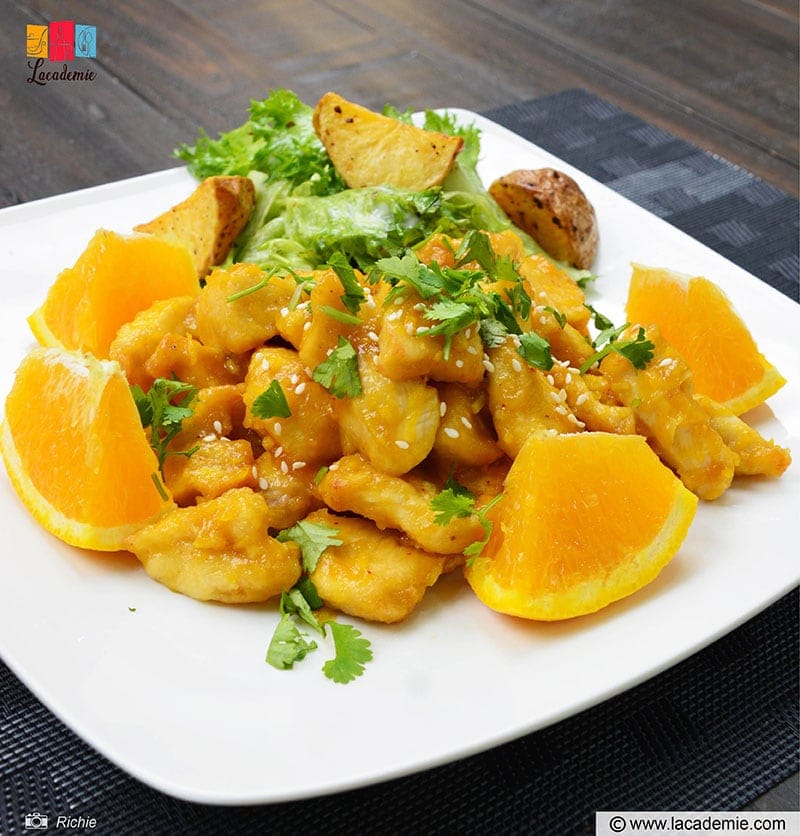
The dish known as “tangerine chicken” may have its origins in Hunan province, China, where a similar dish is known as “dried citrus peel chicken.”
However, due to cultural and geographical factors, the recipe and flavor of the dish has evolved. In American Chinese restaurants, fresh orange peel is often used instead of tangerine, or the dish may not contain any citrus peel at all.
This will continue to be a dish that goes well with white rice rather than eating it without. From the alluring appearance to the yummy taste, you certainly have nothing to complain about in this dish.
Coated with an eye-catching orange shade with the perfect combination of sweet sauce and the mild sourness of citrus fruit like oranges, nothing can go wrong here. Preparing this dish is wise if you want Chinese inspiration for your Christmas party.
31. Chinese Hot Dog Buns
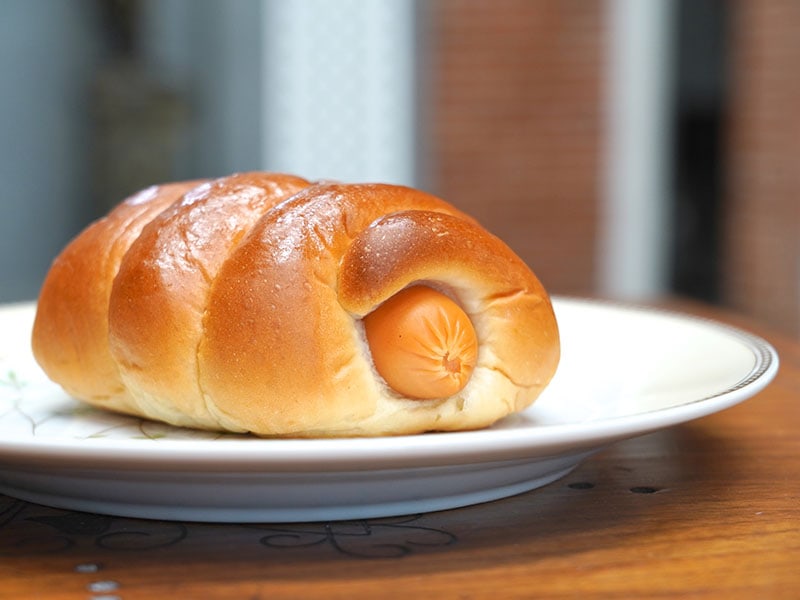
This is definitely not a traditional Chinese dish as its filling is a Western-style sausage, which seems to be why it is called a “hot dog”.
The only difference between this Chinese fusion hot dog and the original one is that instead of sandwiching them in the middle of a regular bread bun, you will roll the dough around the sausage (or stuff it inside the dough) and then bake them all together.
Don’t underestimate this humble food; it has always been a part of Chinese children’s childhood (as a delicious snack or a quick breakfast), and it can also play a role in your life.
32. Chinese Egg Roll
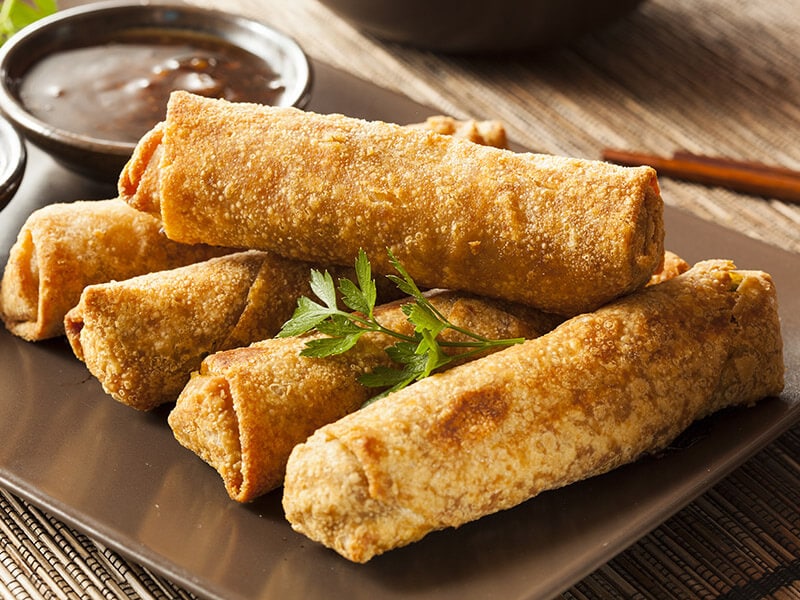
Other Asian countries have their own versions of rolls, but these Chinese egg rolls are particularly stunning. Several features set egg rolls apart from spring rolls, so it’s best not to confuse between spring rolls and egg rolls – they’re two completely different dishes.
One misunderstanding about this delicacy is it is not a traditional Chinese food since it was created in America in the 1930s. Later on, it became one of the most famous Chinese dishes in America and worldwide since they are tasty and easy to eat by anyone.
Crunchy and crumbly on the exterior with crisp skins with the interior soft and moist, this American-Chinese dish makes you unable to stop in the first roll.
33. Chinese-Styled Mongolian Lamb
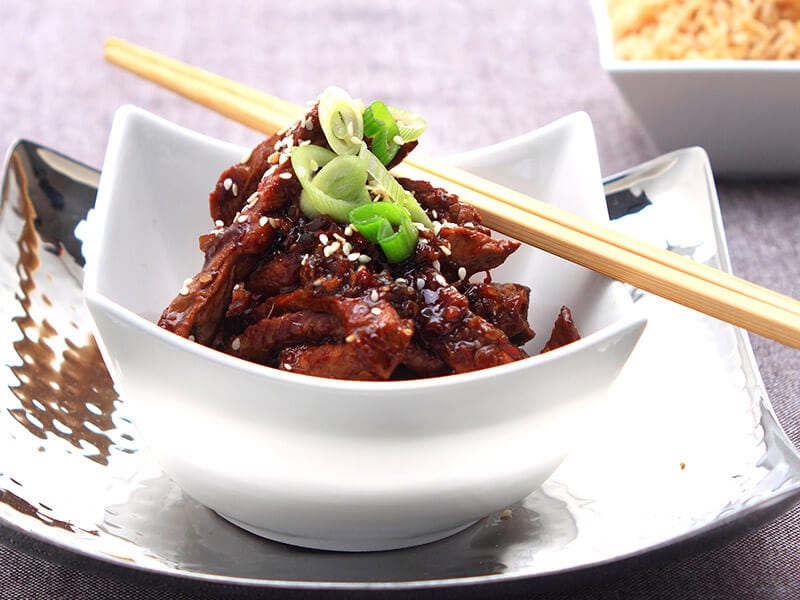
Mongolian Lamb is a stir fry dish popular in Chinese cuisine, featuring tender strips of lamb marinated in a sweet and savory sauce flavored with Chinese five spice.
Despite its name, this dish has no discernible roots in Mongolian cuisine and is not traditionally considered a Chinese dish either.
The dominant flavors of this fusion recipe will be full of onions’ peppery/robust tastes and solid sweetness from the unique sticky sauce. Those flavors will match well with the gamey, grassy, pastoral, and well-balanced fatty lamb meat.
34. Chinese-Japanese Mapo Eggplants (Mabo Nasu)
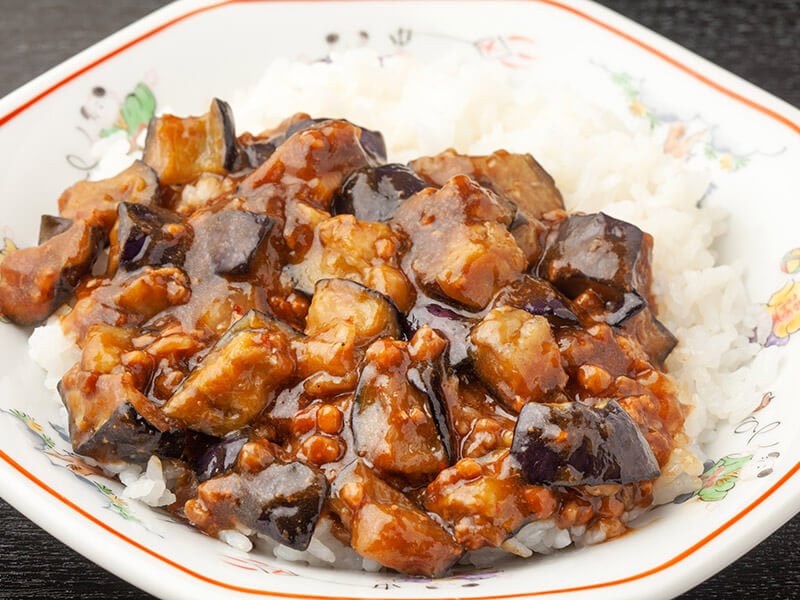
Using the typical spicy spices of Mapo tofu, this eggplant variation still brings back the familiar features besides the modified aspects in ingredients.
After being cooked, the eggplants will be stripped of the signature “vegetable” smell and only retain the mellow taste with a soft texture. Some Japanese-inspired Mapo Eggplant recipes use miso soup instead of soy sauce or typical Japanese condiments.
So, if you are both a fan of Chinese and Japanese cuisine, this dish should be on your wait-to-eat list.
FAQs
Looking to learn more about Chinese foods? My FAQs section is here to help you.
It Is Time To Create An Authentic Chinese Feast!
Chinese cuisine is now extensively available around the world, and you can find it in any area or region, particularly in Asian towns. Therefore, if you have the opportunity, you must taste the delectable delicacies that I have presented today.
Alternatively, if you’ve tried them, please tell me about your experiences or recommend restaurants where you can get these tasteful dishes in the comment section so that I will be able to try them with you. Loving is sharing!
